Enterprise, Innovation & Creativity: Cadbury Business Plan Report
VerifiedAdded on 2023/06/10
|24
|4561
|136
Report
AI Summary
This report presents a comprehensive business plan for Cadbury, a multinational confectionery company. It begins with an introduction outlining the plan's objectives and scope, focusing on an innovative product idea for Cadbury Dairy Milk. The report includes an executive summary, followed by an analysis of Cadbury's mission, vision, and organizational culture. It then delves into a company description and opportunity analyses, including PESTEL, SWOT, and Porter's Five Forces analyses to assess the external environment and competitive landscape. The report outlines a marketing strategy and plan, covering segmentation and the marketing mix. Furthermore, it addresses limiting and allowing factors for the business venture, along with success metrics and a budget. The report concludes with a summary of key findings and recommendations for Cadbury's strategic development, innovation, and market positioning. The report aims to provide a detailed overview of the company's current state and future prospects.
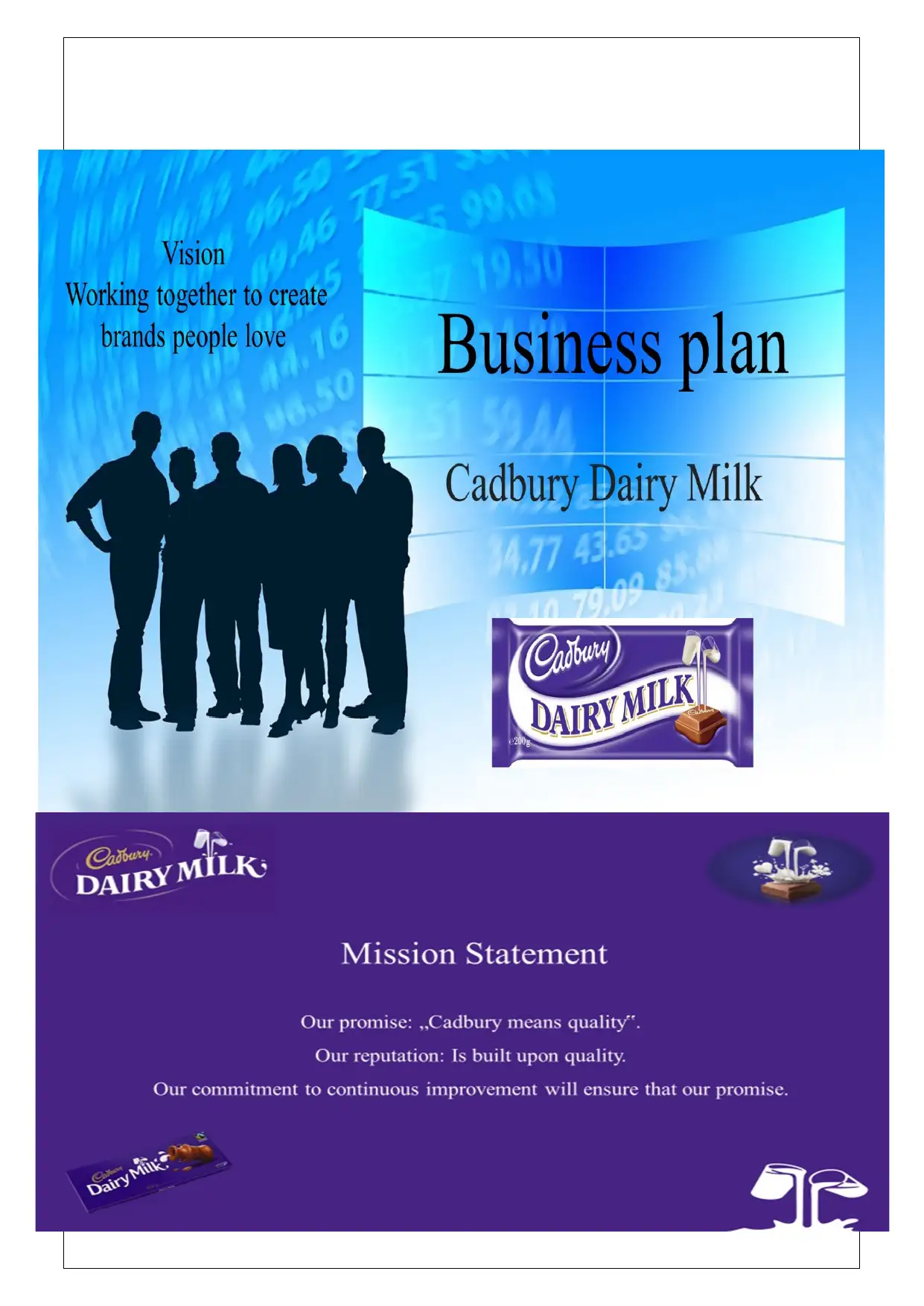
Paraphrase This Document
Need a fresh take? Get an instant paraphrase of this document with our AI Paraphraser

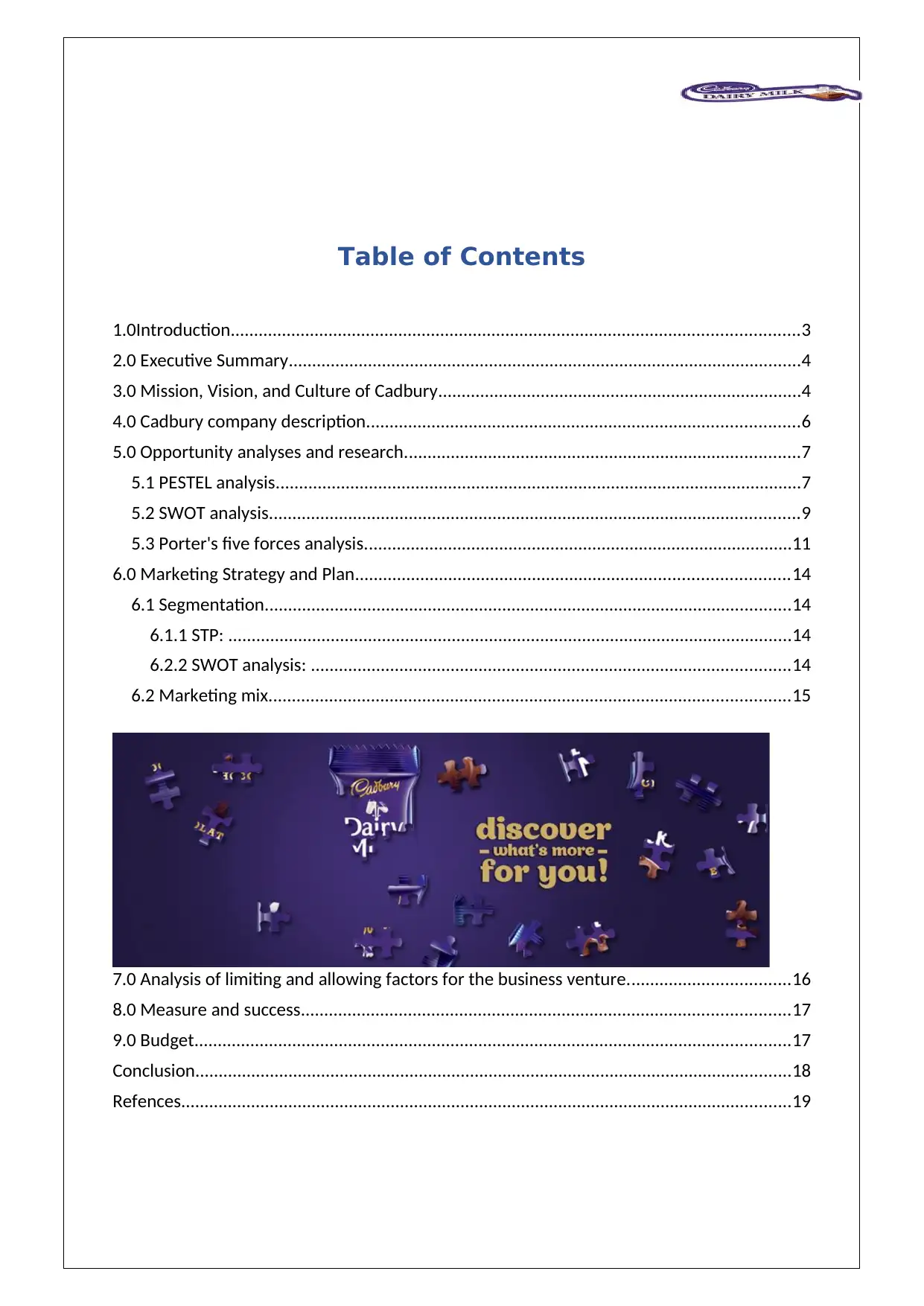
Table of Contents
1.0Introduction..........................................................................................................................3
2.0 Executive Summary..............................................................................................................4
3.0 Mission, Vision, and Culture of Cadbury..............................................................................4
4.0 Cadbury company description.............................................................................................6
5.0 Opportunity analyses and research.....................................................................................7
5.1 PESTEL analysis.................................................................................................................7
5.2 SWOT analysis..................................................................................................................9
5.3 Porter's five forces analysis............................................................................................11
6.0 Marketing Strategy and Plan.............................................................................................14
6.1 Segmentation.................................................................................................................14
6.1.1 STP: .........................................................................................................................14
6.2.2 SWOT analysis: .......................................................................................................14
6.2 Marketing mix................................................................................................................15
7.0 Analysis of limiting and allowing factors for the business venture...................................16
8.0 Measure and success.........................................................................................................17
9.0 Budget................................................................................................................................17
Conclusion................................................................................................................................18
Refences...................................................................................................................................19
1.0Introduction..........................................................................................................................3
2.0 Executive Summary..............................................................................................................4
3.0 Mission, Vision, and Culture of Cadbury..............................................................................4
4.0 Cadbury company description.............................................................................................6
5.0 Opportunity analyses and research.....................................................................................7
5.1 PESTEL analysis.................................................................................................................7
5.2 SWOT analysis..................................................................................................................9
5.3 Porter's five forces analysis............................................................................................11
6.0 Marketing Strategy and Plan.............................................................................................14
6.1 Segmentation.................................................................................................................14
6.1.1 STP: .........................................................................................................................14
6.2.2 SWOT analysis: .......................................................................................................14
6.2 Marketing mix................................................................................................................15
7.0 Analysis of limiting and allowing factors for the business venture...................................16
8.0 Measure and success.........................................................................................................17
9.0 Budget................................................................................................................................17
Conclusion................................................................................................................................18
Refences...................................................................................................................................19
⊘ This is a preview!⊘
Do you want full access?
Subscribe today to unlock all pages.

Trusted by 1+ million students worldwide
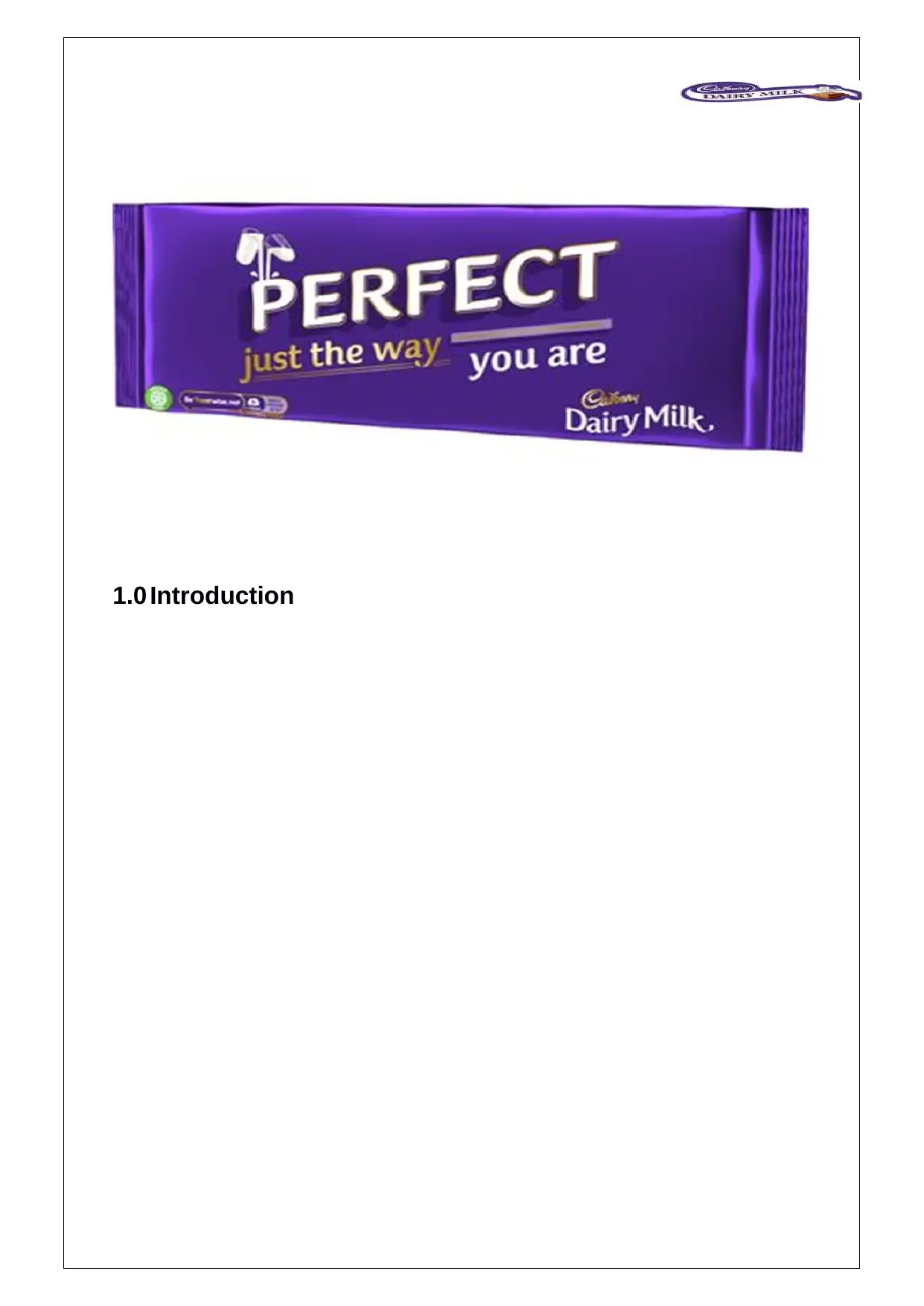
1.0 Introduction
Paraphrase This Document
Need a fresh take? Get an instant paraphrase of this document with our AI Paraphraser
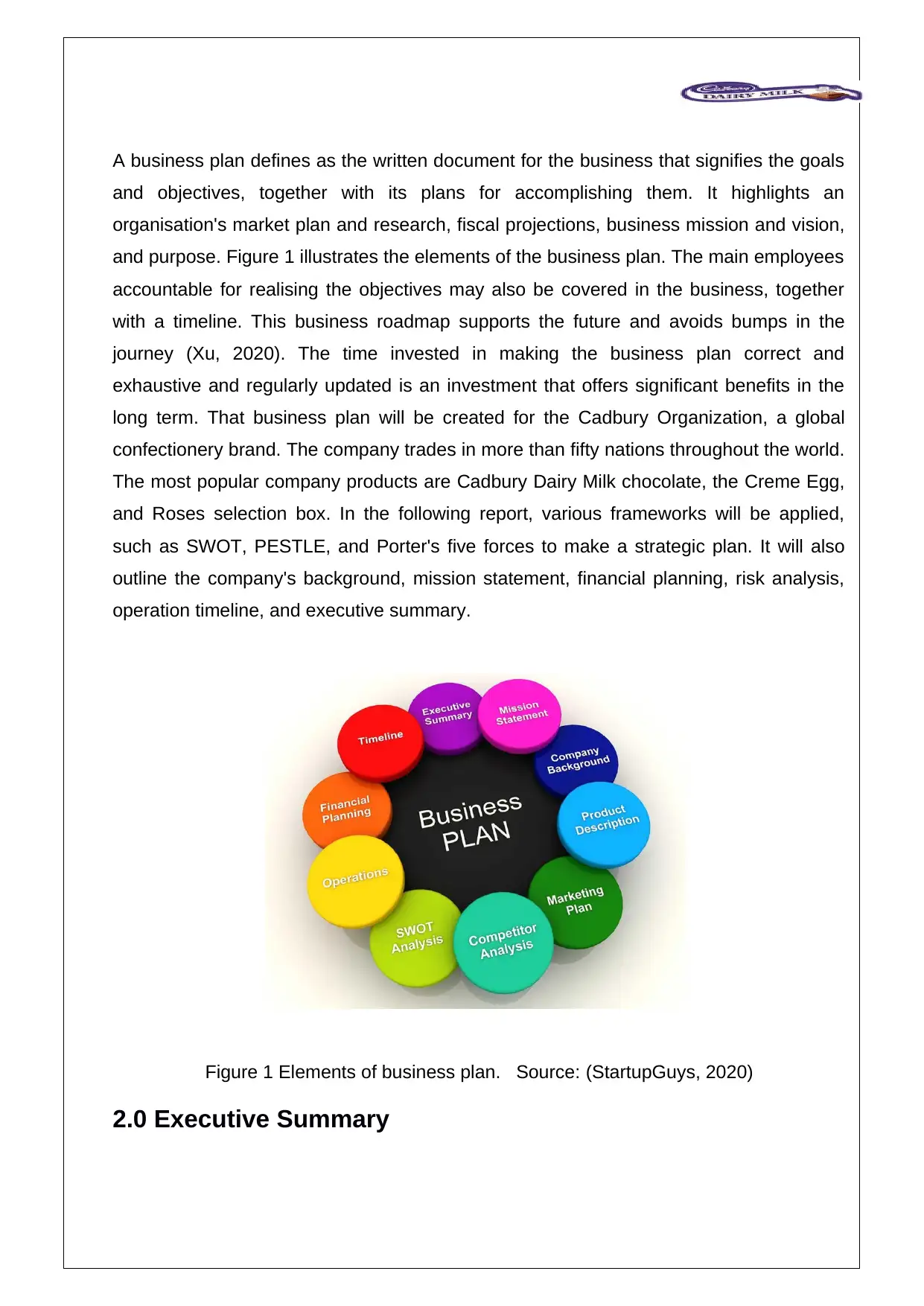
A business plan defines as the written document for the business that signifies the goals
and objectives, together with its plans for accomplishing them. It highlights an
organisation's market plan and research, fiscal projections, business mission and vision,
and purpose. Figure 1 illustrates the elements of the business plan. The main employees
accountable for realising the objectives may also be covered in the business, together
with a timeline. This business roadmap supports the future and avoids bumps in the
journey (Xu, 2020). The time invested in making the business plan correct and
exhaustive and regularly updated is an investment that offers significant benefits in the
long term. That business plan will be created for the Cadbury Organization, a global
confectionery brand. The company trades in more than fifty nations throughout the world.
The most popular company products are Cadbury Dairy Milk chocolate, the Creme Egg,
and Roses selection box. In the following report, various frameworks will be applied,
such as SWOT, PESTLE, and Porter's five forces to make a strategic plan. It will also
outline the company's background, mission statement, financial planning, risk analysis,
operation timeline, and executive summary.
Figure 1 Elements of business plan. Source: (StartupGuys, 2020)
2.0 Executive Summary
and objectives, together with its plans for accomplishing them. It highlights an
organisation's market plan and research, fiscal projections, business mission and vision,
and purpose. Figure 1 illustrates the elements of the business plan. The main employees
accountable for realising the objectives may also be covered in the business, together
with a timeline. This business roadmap supports the future and avoids bumps in the
journey (Xu, 2020). The time invested in making the business plan correct and
exhaustive and regularly updated is an investment that offers significant benefits in the
long term. That business plan will be created for the Cadbury Organization, a global
confectionery brand. The company trades in more than fifty nations throughout the world.
The most popular company products are Cadbury Dairy Milk chocolate, the Creme Egg,
and Roses selection box. In the following report, various frameworks will be applied,
such as SWOT, PESTLE, and Porter's five forces to make a strategic plan. It will also
outline the company's background, mission statement, financial planning, risk analysis,
operation timeline, and executive summary.
Figure 1 Elements of business plan. Source: (StartupGuys, 2020)
2.0 Executive Summary
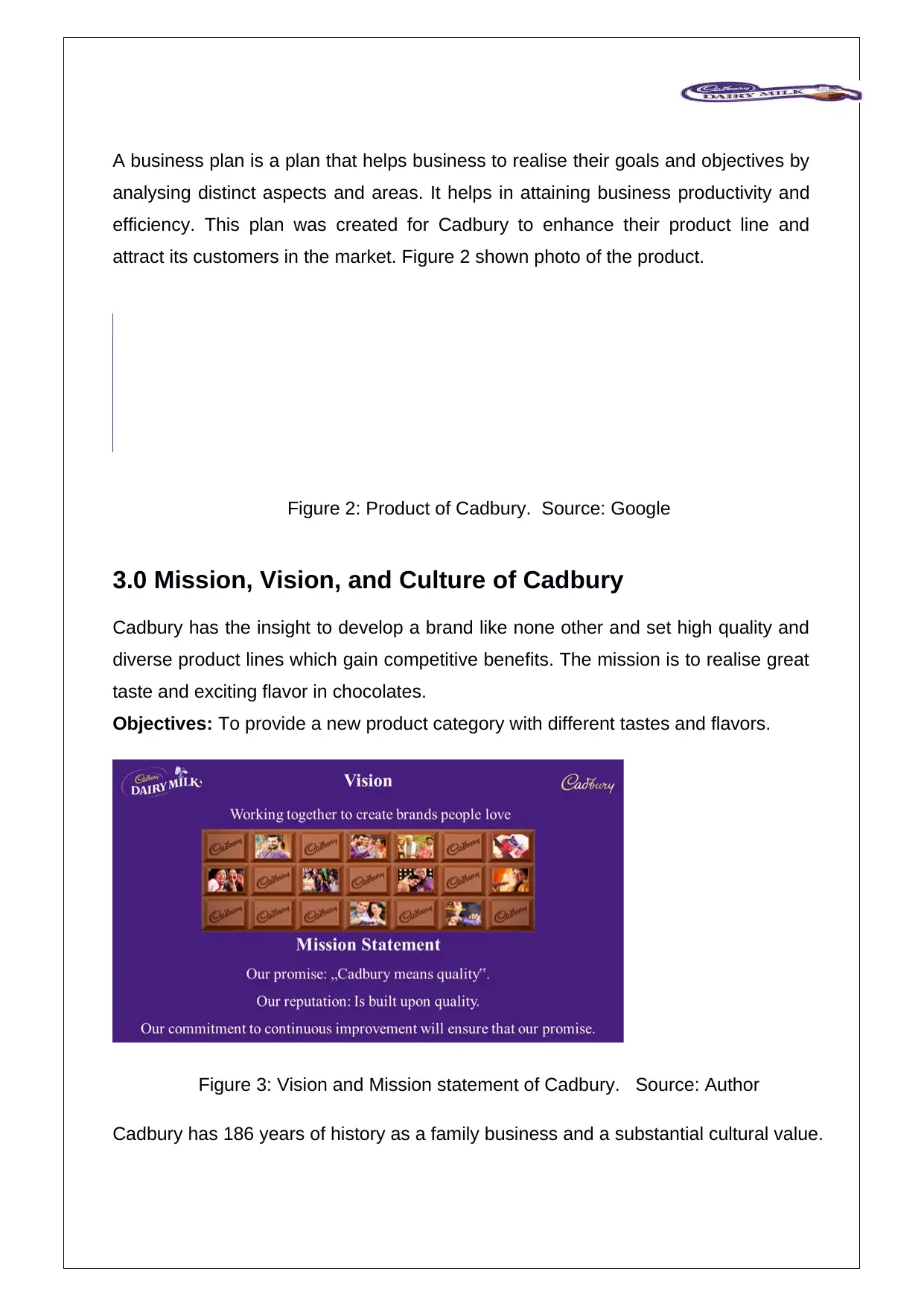
A business plan is a plan that helps business to realise their goals and objectives by
analysing distinct aspects and areas. It helps in attaining business productivity and
efficiency. This plan was created for Cadbury to enhance their product line and
attract its customers in the market. Figure 2 shown photo of the product.
Figure 2: Product of Cadbury. Source: Google
3.0 Mission, Vision, and Culture of Cadbury
Cadbury has the insight to develop a brand like none other and set high quality and
diverse product lines which gain competitive benefits. The mission is to realise great
taste and exciting flavor in chocolates.
Objectives: To provide a new product category with different tastes and flavors.
Figure 3: Vision and Mission statement of Cadbury. Source: Author
Cadbury has 186 years of history as a family business and a substantial cultural value.
analysing distinct aspects and areas. It helps in attaining business productivity and
efficiency. This plan was created for Cadbury to enhance their product line and
attract its customers in the market. Figure 2 shown photo of the product.
Figure 2: Product of Cadbury. Source: Google
3.0 Mission, Vision, and Culture of Cadbury
Cadbury has the insight to develop a brand like none other and set high quality and
diverse product lines which gain competitive benefits. The mission is to realise great
taste and exciting flavor in chocolates.
Objectives: To provide a new product category with different tastes and flavors.
Figure 3: Vision and Mission statement of Cadbury. Source: Author
Cadbury has 186 years of history as a family business and a substantial cultural value.
⊘ This is a preview!⊘
Do you want full access?
Subscribe today to unlock all pages.

Trusted by 1+ million students worldwide
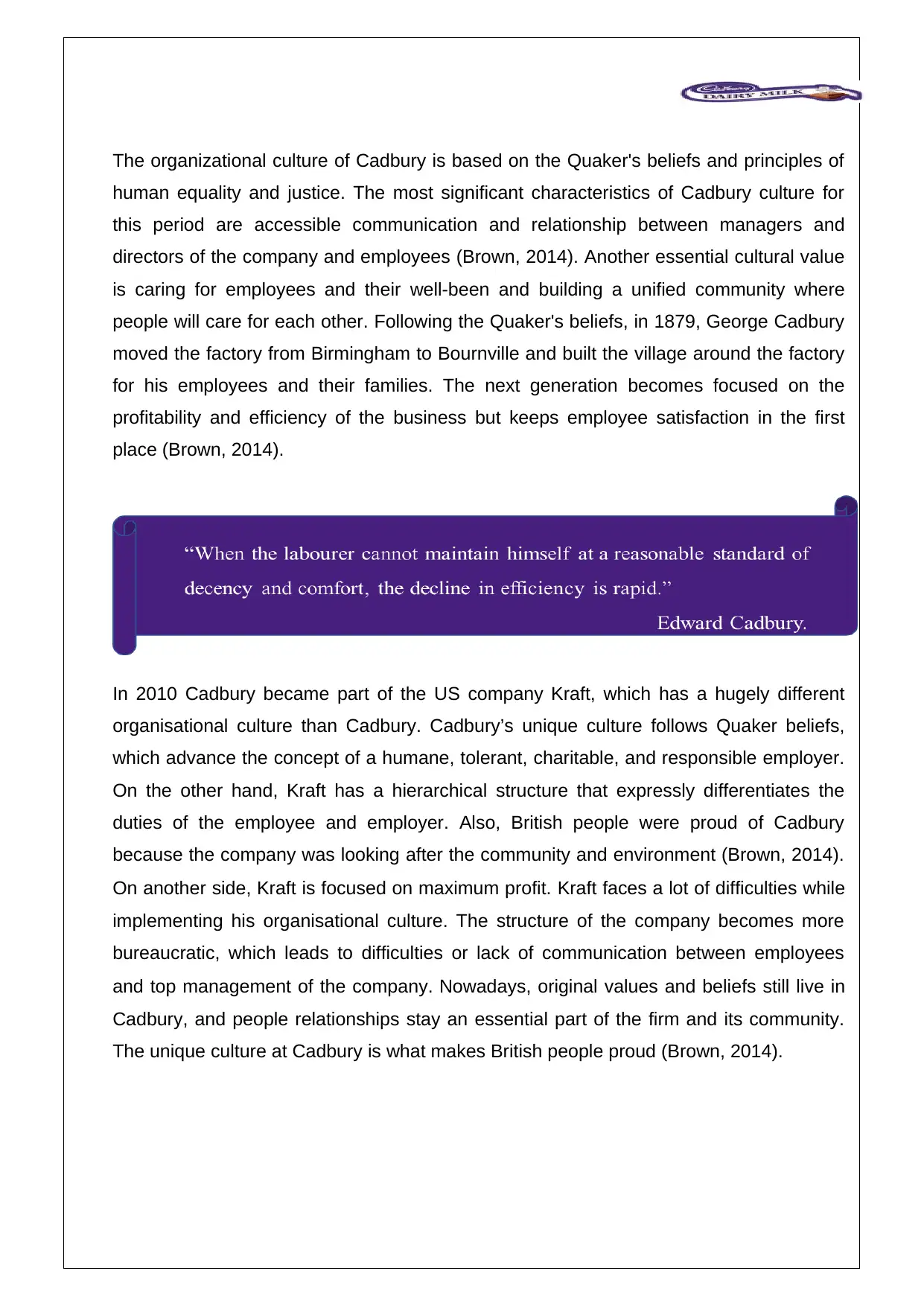
The organizational culture of Cadbury is based on the Quaker's beliefs and principles of
human equality and justice. The most significant characteristics of Cadbury culture for
this period are accessible communication and relationship between managers and
directors of the company and employees (Brown, 2014). Another essential cultural value
is caring for employees and their well-been and building a unified community where
people will care for each other. Following the Quaker's beliefs, in 1879, George Cadbury
moved the factory from Birmingham to Bournville and built the village around the factory
for his employees and their families. The next generation becomes focused on the
profitability and efficiency of the business but keeps employee satisfaction in the first
place (Brown, 2014).
In 2010 Cadbury became part of the US company Kraft, which has a hugely different
organisational culture than Cadbury. Cadbury’s unique culture follows Quaker beliefs,
which advance the concept of a humane, tolerant, charitable, and responsible employer.
On the other hand, Kraft has a hierarchical structure that expressly differentiates the
duties of the employee and employer. Also, British people were proud of Cadbury
because the company was looking after the community and environment (Brown, 2014).
On another side, Kraft is focused on maximum profit. Kraft faces a lot of difficulties while
implementing his organisational culture. The structure of the company becomes more
bureaucratic, which leads to difficulties or lack of communication between employees
and top management of the company. Nowadays, original values and beliefs still live in
Cadbury, and people relationships stay an essential part of the firm and its community.
The unique culture at Cadbury is what makes British people proud (Brown, 2014).
human equality and justice. The most significant characteristics of Cadbury culture for
this period are accessible communication and relationship between managers and
directors of the company and employees (Brown, 2014). Another essential cultural value
is caring for employees and their well-been and building a unified community where
people will care for each other. Following the Quaker's beliefs, in 1879, George Cadbury
moved the factory from Birmingham to Bournville and built the village around the factory
for his employees and their families. The next generation becomes focused on the
profitability and efficiency of the business but keeps employee satisfaction in the first
place (Brown, 2014).
In 2010 Cadbury became part of the US company Kraft, which has a hugely different
organisational culture than Cadbury. Cadbury’s unique culture follows Quaker beliefs,
which advance the concept of a humane, tolerant, charitable, and responsible employer.
On the other hand, Kraft has a hierarchical structure that expressly differentiates the
duties of the employee and employer. Also, British people were proud of Cadbury
because the company was looking after the community and environment (Brown, 2014).
On another side, Kraft is focused on maximum profit. Kraft faces a lot of difficulties while
implementing his organisational culture. The structure of the company becomes more
bureaucratic, which leads to difficulties or lack of communication between employees
and top management of the company. Nowadays, original values and beliefs still live in
Cadbury, and people relationships stay an essential part of the firm and its community.
The unique culture at Cadbury is what makes British people proud (Brown, 2014).
Paraphrase This Document
Need a fresh take? Get an instant paraphrase of this document with our AI Paraphraser
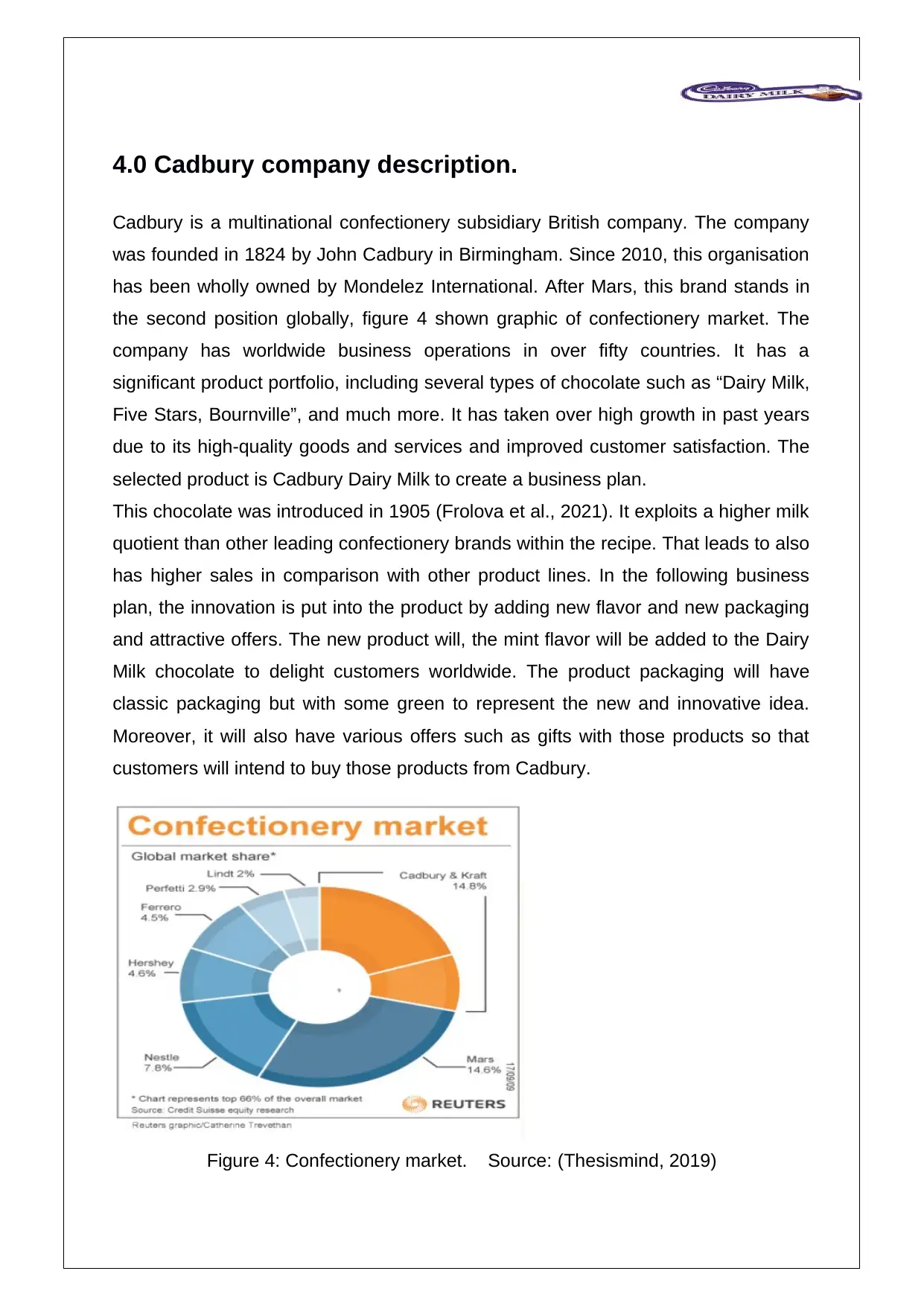
4.0 Cadbury company description.
Cadbury is a multinational confectionery subsidiary British company. The company
was founded in 1824 by John Cadbury in Birmingham. Since 2010, this organisation
has been wholly owned by Mondelez International. After Mars, this brand stands in
the second position globally, figure 4 shown graphic of confectionery market. The
company has worldwide business operations in over fifty countries. It has a
significant product portfolio, including several types of chocolate such as “Dairy Milk,
Five Stars, Bournville”, and much more. It has taken over high growth in past years
due to its high-quality goods and services and improved customer satisfaction. The
selected product is Cadbury Dairy Milk to create a business plan.
This chocolate was introduced in 1905 (Frolova et al., 2021). It exploits a higher milk
quotient than other leading confectionery brands within the recipe. That leads to also
has higher sales in comparison with other product lines. In the following business
plan, the innovation is put into the product by adding new flavor and new packaging
and attractive offers. The new product will, the mint flavor will be added to the Dairy
Milk chocolate to delight customers worldwide. The product packaging will have
classic packaging but with some green to represent the new and innovative idea.
Moreover, it will also have various offers such as gifts with those products so that
customers will intend to buy those products from Cadbury.
Figure 4: Confectionery market. Source: (Thesismind, 2019)
Cadbury is a multinational confectionery subsidiary British company. The company
was founded in 1824 by John Cadbury in Birmingham. Since 2010, this organisation
has been wholly owned by Mondelez International. After Mars, this brand stands in
the second position globally, figure 4 shown graphic of confectionery market. The
company has worldwide business operations in over fifty countries. It has a
significant product portfolio, including several types of chocolate such as “Dairy Milk,
Five Stars, Bournville”, and much more. It has taken over high growth in past years
due to its high-quality goods and services and improved customer satisfaction. The
selected product is Cadbury Dairy Milk to create a business plan.
This chocolate was introduced in 1905 (Frolova et al., 2021). It exploits a higher milk
quotient than other leading confectionery brands within the recipe. That leads to also
has higher sales in comparison with other product lines. In the following business
plan, the innovation is put into the product by adding new flavor and new packaging
and attractive offers. The new product will, the mint flavor will be added to the Dairy
Milk chocolate to delight customers worldwide. The product packaging will have
classic packaging but with some green to represent the new and innovative idea.
Moreover, it will also have various offers such as gifts with those products so that
customers will intend to buy those products from Cadbury.
Figure 4: Confectionery market. Source: (Thesismind, 2019)
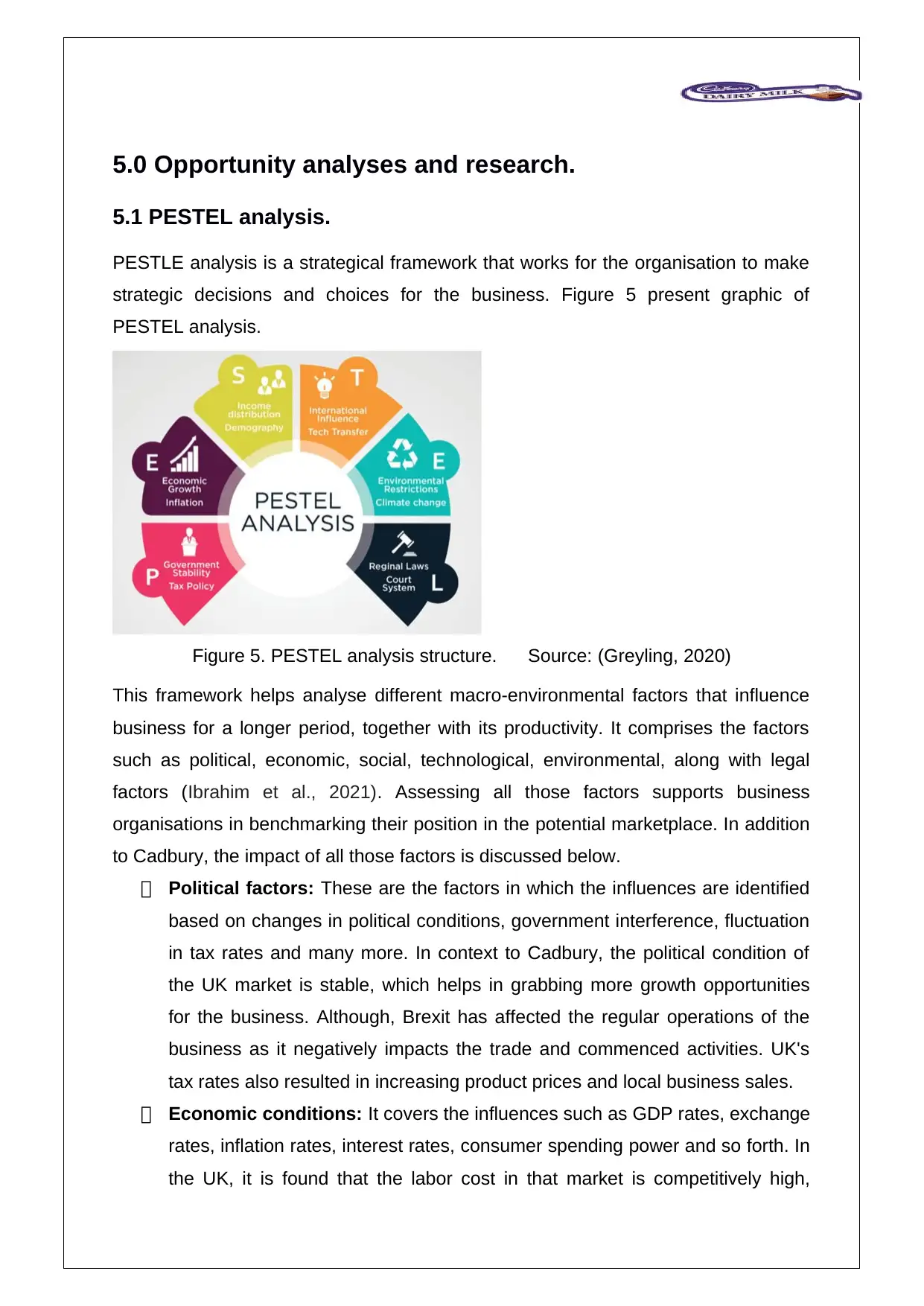
5.0 Opportunity analyses and research.
5.1 PESTEL analysis.
PESTLE analysis is a strategical framework that works for the organisation to make
strategic decisions and choices for the business. Figure 5 present graphic of
PESTEL analysis.
Figure 5. PESTEL analysis structure. Source: (Greyling, 2020)
This framework helps analyse different macro-environmental factors that influence
business for a longer period, together with its productivity. It comprises the factors
such as political, economic, social, technological, environmental, along with legal
factors (Ibrahim et al., 2021). Assessing all those factors supports business
organisations in benchmarking their position in the potential marketplace. In addition
to Cadbury, the impact of all those factors is discussed below.
Political factors: These are the factors in which the influences are identified
based on changes in political conditions, government interference, fluctuation
in tax rates and many more. In context to Cadbury, the political condition of
the UK market is stable, which helps in grabbing more growth opportunities
for the business. Although, Brexit has affected the regular operations of the
business as it negatively impacts the trade and commenced activities. UK's
tax rates also resulted in increasing product prices and local business sales.
Economic conditions: It covers the influences such as GDP rates, exchange
rates, inflation rates, interest rates, consumer spending power and so forth. In
the UK, it is found that the labor cost in that market is competitively high,
5.1 PESTEL analysis.
PESTLE analysis is a strategical framework that works for the organisation to make
strategic decisions and choices for the business. Figure 5 present graphic of
PESTEL analysis.
Figure 5. PESTEL analysis structure. Source: (Greyling, 2020)
This framework helps analyse different macro-environmental factors that influence
business for a longer period, together with its productivity. It comprises the factors
such as political, economic, social, technological, environmental, along with legal
factors (Ibrahim et al., 2021). Assessing all those factors supports business
organisations in benchmarking their position in the potential marketplace. In addition
to Cadbury, the impact of all those factors is discussed below.
Political factors: These are the factors in which the influences are identified
based on changes in political conditions, government interference, fluctuation
in tax rates and many more. In context to Cadbury, the political condition of
the UK market is stable, which helps in grabbing more growth opportunities
for the business. Although, Brexit has affected the regular operations of the
business as it negatively impacts the trade and commenced activities. UK's
tax rates also resulted in increasing product prices and local business sales.
Economic conditions: It covers the influences such as GDP rates, exchange
rates, inflation rates, interest rates, consumer spending power and so forth. In
the UK, it is found that the labor cost in that market is competitively high,
⊘ This is a preview!⊘
Do you want full access?
Subscribe today to unlock all pages.

Trusted by 1+ million students worldwide
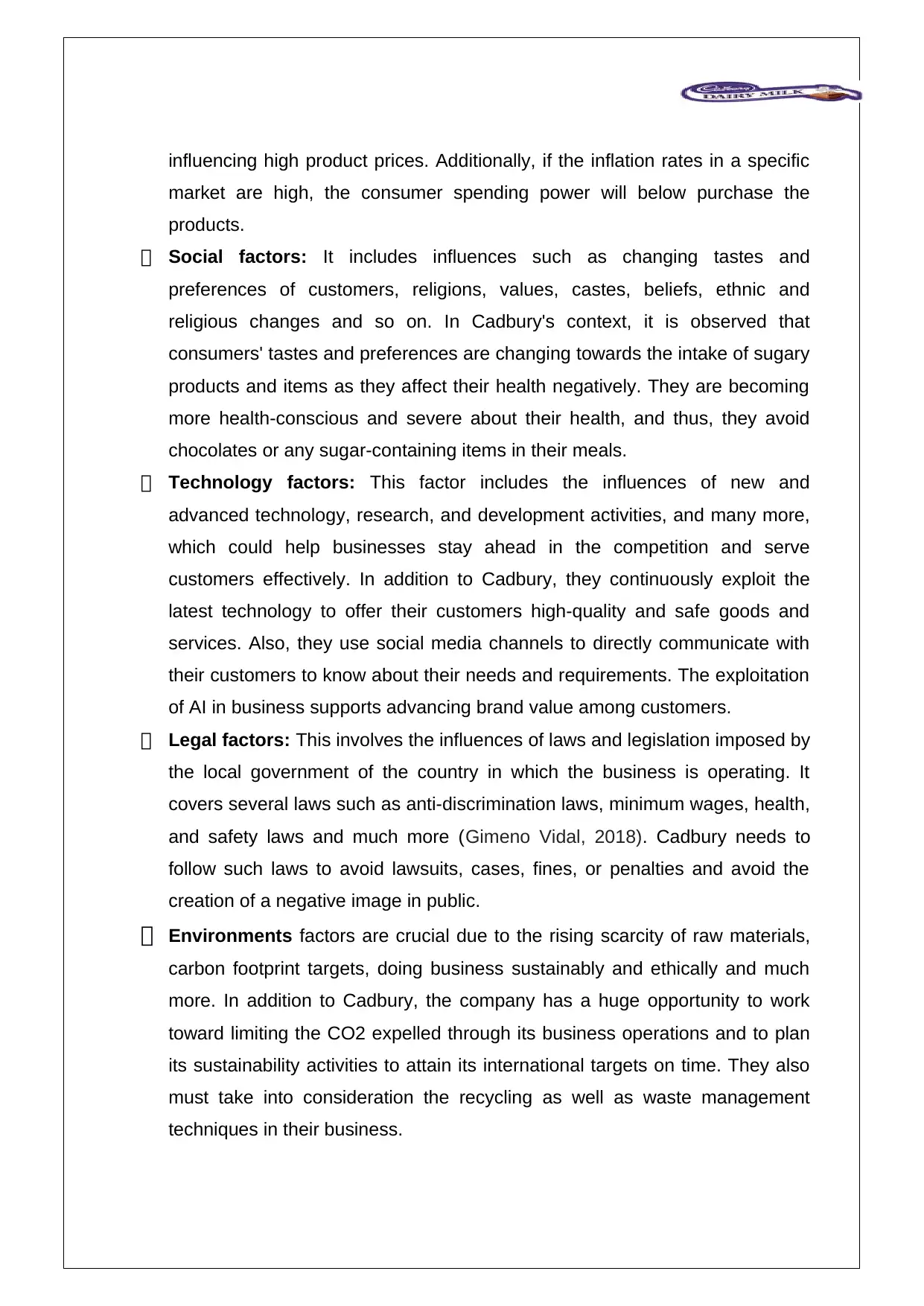
influencing high product prices. Additionally, if the inflation rates in a specific
market are high, the consumer spending power will below purchase the
products.
Social factors: It includes influences such as changing tastes and
preferences of customers, religions, values, castes, beliefs, ethnic and
religious changes and so on. In Cadbury's context, it is observed that
consumers' tastes and preferences are changing towards the intake of sugary
products and items as they affect their health negatively. They are becoming
more health-conscious and severe about their health, and thus, they avoid
chocolates or any sugar-containing items in their meals.
Technology factors: This factor includes the influences of new and
advanced technology, research, and development activities, and many more,
which could help businesses stay ahead in the competition and serve
customers effectively. In addition to Cadbury, they continuously exploit the
latest technology to offer their customers high-quality and safe goods and
services. Also, they use social media channels to directly communicate with
their customers to know about their needs and requirements. The exploitation
of AI in business supports advancing brand value among customers.
Legal factors: This involves the influences of laws and legislation imposed by
the local government of the country in which the business is operating. It
covers several laws such as anti-discrimination laws, minimum wages, health,
and safety laws and much more (Gimeno Vidal, 2018). Cadbury needs to
follow such laws to avoid lawsuits, cases, fines, or penalties and avoid the
creation of a negative image in public.
Environments factors are crucial due to the rising scarcity of raw materials,
carbon footprint targets, doing business sustainably and ethically and much
more. In addition to Cadbury, the company has a huge opportunity to work
toward limiting the CO2 expelled through its business operations and to plan
its sustainability activities to attain its international targets on time. They also
must take into consideration the recycling as well as waste management
techniques in their business.
market are high, the consumer spending power will below purchase the
products.
Social factors: It includes influences such as changing tastes and
preferences of customers, religions, values, castes, beliefs, ethnic and
religious changes and so on. In Cadbury's context, it is observed that
consumers' tastes and preferences are changing towards the intake of sugary
products and items as they affect their health negatively. They are becoming
more health-conscious and severe about their health, and thus, they avoid
chocolates or any sugar-containing items in their meals.
Technology factors: This factor includes the influences of new and
advanced technology, research, and development activities, and many more,
which could help businesses stay ahead in the competition and serve
customers effectively. In addition to Cadbury, they continuously exploit the
latest technology to offer their customers high-quality and safe goods and
services. Also, they use social media channels to directly communicate with
their customers to know about their needs and requirements. The exploitation
of AI in business supports advancing brand value among customers.
Legal factors: This involves the influences of laws and legislation imposed by
the local government of the country in which the business is operating. It
covers several laws such as anti-discrimination laws, minimum wages, health,
and safety laws and much more (Gimeno Vidal, 2018). Cadbury needs to
follow such laws to avoid lawsuits, cases, fines, or penalties and avoid the
creation of a negative image in public.
Environments factors are crucial due to the rising scarcity of raw materials,
carbon footprint targets, doing business sustainably and ethically and much
more. In addition to Cadbury, the company has a huge opportunity to work
toward limiting the CO2 expelled through its business operations and to plan
its sustainability activities to attain its international targets on time. They also
must take into consideration the recycling as well as waste management
techniques in their business.
Paraphrase This Document
Need a fresh take? Get an instant paraphrase of this document with our AI Paraphraser
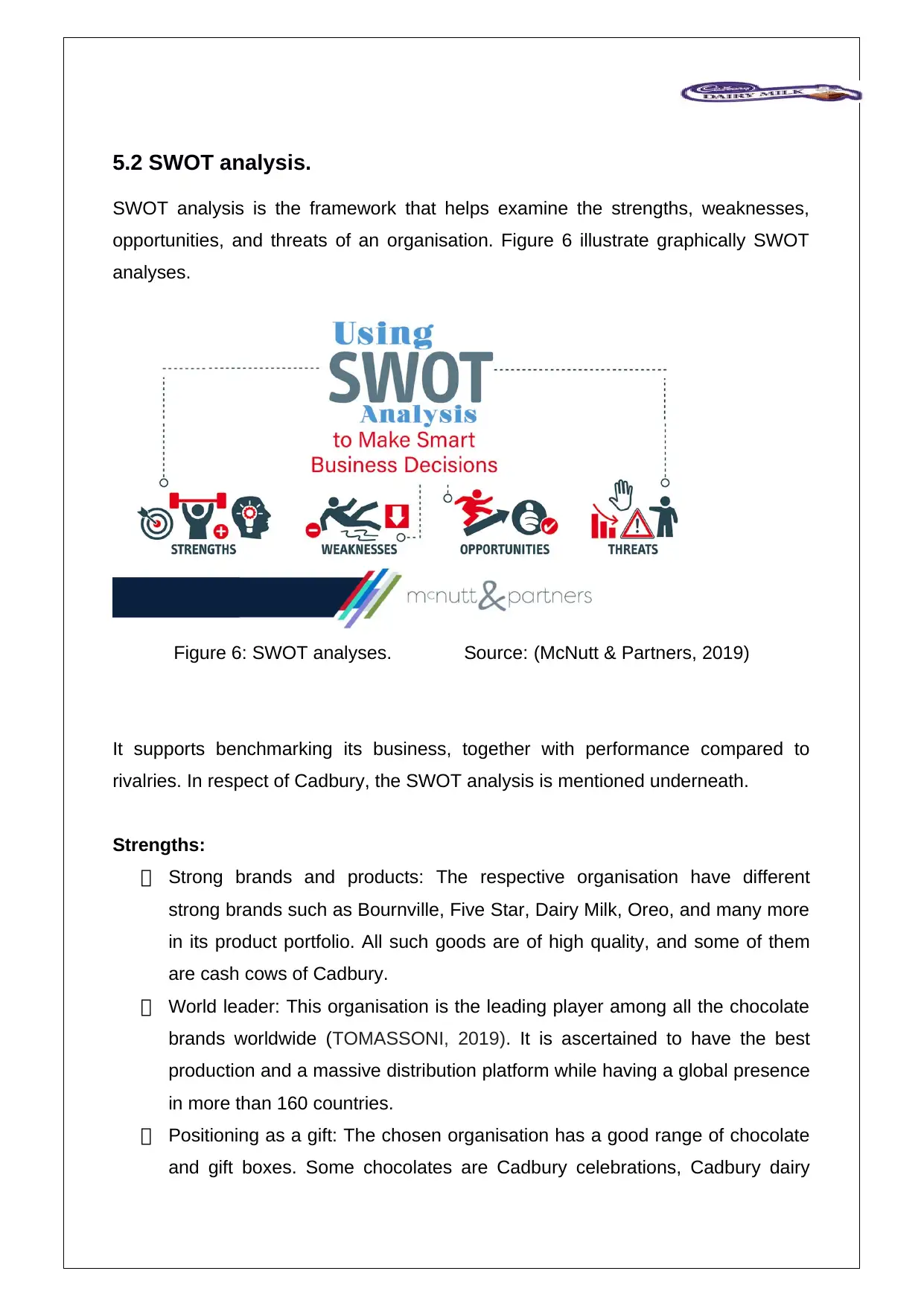
5.2 SWOT analysis.
SWOT analysis is the framework that helps examine the strengths, weaknesses,
opportunities, and threats of an organisation. Figure 6 illustrate graphically SWOT
analyses.
Figure 6: SWOT analyses. Source: (McNutt & Partners, 2019)
It supports benchmarking its business, together with performance compared to
rivalries. In respect of Cadbury, the SWOT analysis is mentioned underneath.
Strengths:
Strong brands and products: The respective organisation have different
strong brands such as Bournville, Five Star, Dairy Milk, Oreo, and many more
in its product portfolio. All such goods are of high quality, and some of them
are cash cows of Cadbury.
World leader: This organisation is the leading player among all the chocolate
brands worldwide (TOMASSONI, 2019). It is ascertained to have the best
production and a massive distribution platform while having a global presence
in more than 160 countries.
Positioning as a gift: The chosen organisation has a good range of chocolate
and gift boxes. Some chocolates are Cadbury celebrations, Cadbury dairy
SWOT analysis is the framework that helps examine the strengths, weaknesses,
opportunities, and threats of an organisation. Figure 6 illustrate graphically SWOT
analyses.
Figure 6: SWOT analyses. Source: (McNutt & Partners, 2019)
It supports benchmarking its business, together with performance compared to
rivalries. In respect of Cadbury, the SWOT analysis is mentioned underneath.
Strengths:
Strong brands and products: The respective organisation have different
strong brands such as Bournville, Five Star, Dairy Milk, Oreo, and many more
in its product portfolio. All such goods are of high quality, and some of them
are cash cows of Cadbury.
World leader: This organisation is the leading player among all the chocolate
brands worldwide (TOMASSONI, 2019). It is ascertained to have the best
production and a massive distribution platform while having a global presence
in more than 160 countries.
Positioning as a gift: The chosen organisation has a good range of chocolate
and gift boxes. Some chocolates are Cadbury celebrations, Cadbury dairy
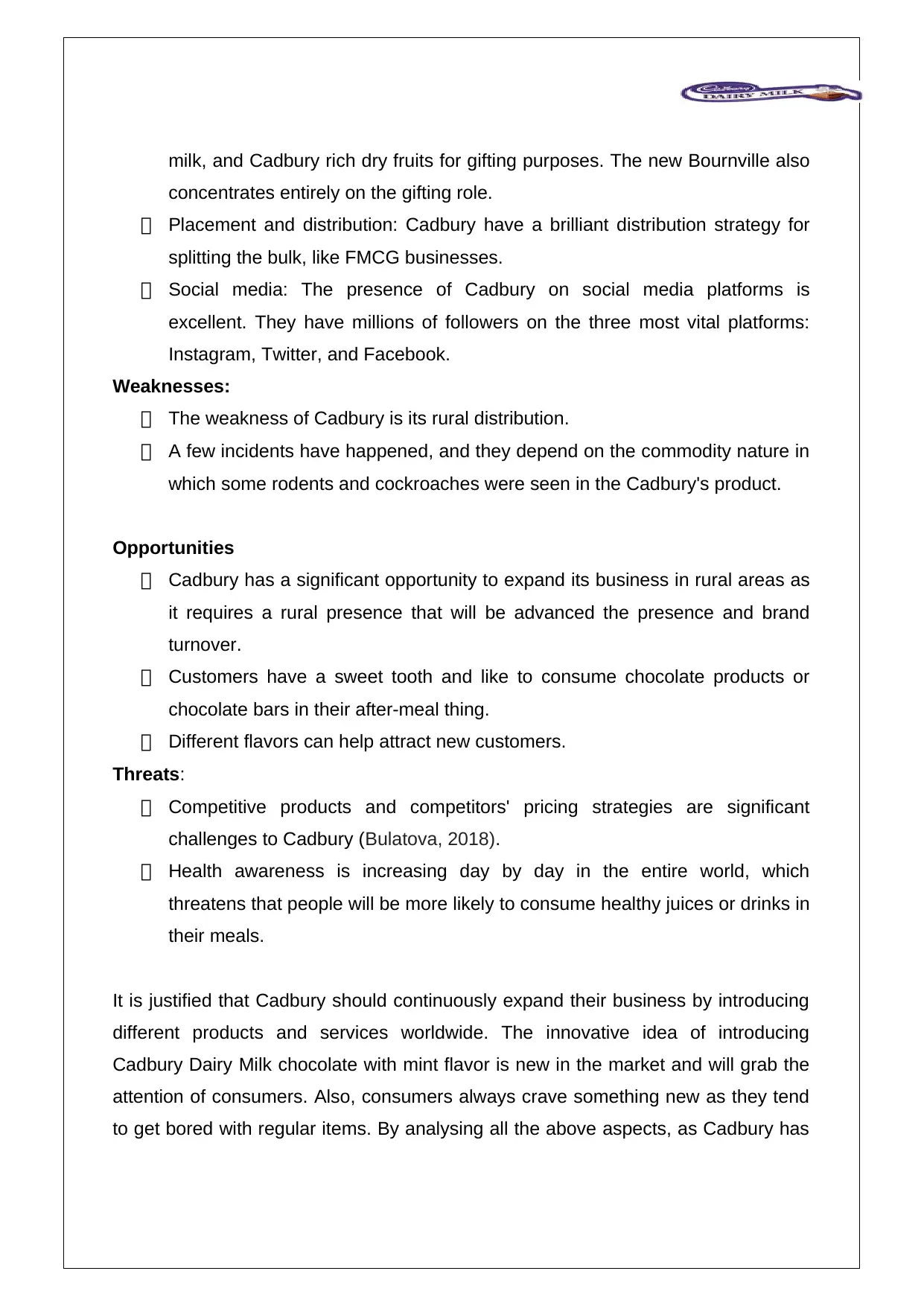
milk, and Cadbury rich dry fruits for gifting purposes. The new Bournville also
concentrates entirely on the gifting role.
Placement and distribution: Cadbury have a brilliant distribution strategy for
splitting the bulk, like FMCG businesses.
Social media: The presence of Cadbury on social media platforms is
excellent. They have millions of followers on the three most vital platforms:
Instagram, Twitter, and Facebook.
Weaknesses:
The weakness of Cadbury is its rural distribution.
A few incidents have happened, and they depend on the commodity nature in
which some rodents and cockroaches were seen in the Cadbury's product.
Opportunities
Cadbury has a significant opportunity to expand its business in rural areas as
it requires a rural presence that will be advanced the presence and brand
turnover.
Customers have a sweet tooth and like to consume chocolate products or
chocolate bars in their after-meal thing.
Different flavors can help attract new customers.
Threats:
Competitive products and competitors' pricing strategies are significant
challenges to Cadbury (Bulatova, 2018).
Health awareness is increasing day by day in the entire world, which
threatens that people will be more likely to consume healthy juices or drinks in
their meals.
It is justified that Cadbury should continuously expand their business by introducing
different products and services worldwide. The innovative idea of introducing
Cadbury Dairy Milk chocolate with mint flavor is new in the market and will grab the
attention of consumers. Also, consumers always crave something new as they tend
to get bored with regular items. By analysing all the above aspects, as Cadbury has
concentrates entirely on the gifting role.
Placement and distribution: Cadbury have a brilliant distribution strategy for
splitting the bulk, like FMCG businesses.
Social media: The presence of Cadbury on social media platforms is
excellent. They have millions of followers on the three most vital platforms:
Instagram, Twitter, and Facebook.
Weaknesses:
The weakness of Cadbury is its rural distribution.
A few incidents have happened, and they depend on the commodity nature in
which some rodents and cockroaches were seen in the Cadbury's product.
Opportunities
Cadbury has a significant opportunity to expand its business in rural areas as
it requires a rural presence that will be advanced the presence and brand
turnover.
Customers have a sweet tooth and like to consume chocolate products or
chocolate bars in their after-meal thing.
Different flavors can help attract new customers.
Threats:
Competitive products and competitors' pricing strategies are significant
challenges to Cadbury (Bulatova, 2018).
Health awareness is increasing day by day in the entire world, which
threatens that people will be more likely to consume healthy juices or drinks in
their meals.
It is justified that Cadbury should continuously expand their business by introducing
different products and services worldwide. The innovative idea of introducing
Cadbury Dairy Milk chocolate with mint flavor is new in the market and will grab the
attention of consumers. Also, consumers always crave something new as they tend
to get bored with regular items. By analysing all the above aspects, as Cadbury has
⊘ This is a preview!⊘
Do you want full access?
Subscribe today to unlock all pages.

Trusted by 1+ million students worldwide
1 out of 24
Related Documents
Your All-in-One AI-Powered Toolkit for Academic Success.
+13062052269
info@desklib.com
Available 24*7 on WhatsApp / Email
![[object Object]](/_next/static/media/star-bottom.7253800d.svg)
Unlock your academic potential
Copyright © 2020–2025 A2Z Services. All Rights Reserved. Developed and managed by ZUCOL.




